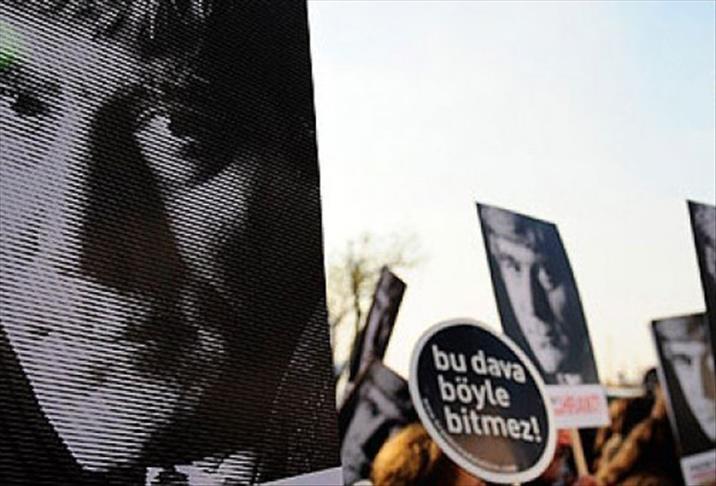Hrant Dink: A life dedicated to Turkey's democratization
Friends of prominent journalist Hrant Dink remember the day of his murder eight years ago

By Handan Kazanci
ISTANBUL
“I am an Armenian, a member of Turkey and an Anatolian to the marrow,” once wrote prominent journalist Hrant Dink.
Monday will mark the eighth anniversary of the day when the 52-year-old reporter’s life was cut short.
Dink was shot in the back by a teenage nationalist on an Istanbul street in broad daylight.
The founder of the country’s first Turkish-Armenian weekly newspaper “Agos,” Dink – who hailed from Turkey’s eastern province of Malatya – was an advocate of democratization and human rights.
He had made a career of trying to open discussion on Turkey’s taboo topics.
“He was also one of the most important intellectuals of Turkey, he traveled around the country,” says Turkish journalist Tuba Candar, who was also a personal friend of Dink.
“He wasn’t only talking about the Armenian issue but also other taboos of the time, such as Kurdish or headscarf matters,” adds Candar who is the author of a major biography of Dink for which she interviewed 125 people.
Dink was repeatedly prosecuted for “denigrating Turkishness” over his articles about Armenian identity and mass deportation of Armenians in 1915, which the country’s diaspora and government still describe as ‘genocide.’
Turkey officially refutes this description.
“In Turkey he was an Armenian, and in the Armenian world he was from Turkey,” says Candar.
Aydin Engin, one of Dink’s friends who contributed to Agos as a columnist between 2002 and 2005, recalls the journalist’s comment when he learned that the French parliament would adopt a bill which would punish those denying the ‘Armenian genocide.’
“Hrant said in a TV interview that ‘I would stand in the heart of Paris and deny Armenian genocide and then come to Ankara and say the Armenian genocide is true.
France would pull my arm while Turkey would the other and in that way they would mangle me but, as an intellectual, I have to say this.'”
According to Engin, while Dink was dealing with prosecutions in Turkey, he was also accused of being a Turkish spy by the Armenian diaspora.
The most important aspect of Hrant was his “diagnosis” on the Armenian issue says Candar: “He was saying that both communities were ill. Armenians still couldn’t get over the 1915 trauma and they constructed the whole Armenian identity on it.
And Turks were suffering from paranoia as they were thinking the recognition of genocide would result in compensation or giving some part of their lands to Armenians.”
“According to him, the only way to recover from this illness was to open the Turkish-Armenian border — which is closed since 1993. If people encounter each other then they can begin to speak and try to solve their problems.”
“He was actually a lonely man within the Armenian community as well,” Candar adds, suggesting a number of “breaking points” in Dink’s life.
First, says Candar, was the separation of Dink’s parents.
“He was abandoned along with his two other brothers after his parents’ divorce and grew up in an Armenian orphanage,” Candar says.
His socialist background was another important element in his life, according to her.
One of his best friends, Armenak Bakirciyan – who later changed his name to Orhan Bakir – was the leader of the Communist Party of Turkey/Marxist-Leninist, an armed far-left group, and was killed during a conflict with Turkish police in 1980.
In common with his friend, Dink also changed his name to a Turkish one – Firat, a reference to Turkey’s renowned filmmaker Yilmaz Guney, who mainly portrayed working-class people’s lives on film.
Although he started to use his real name when he opened Agos, his name was still "Firat" on his identity card until the day he was killed.
- ‘We all saw him lying on the street’
Eight years ago on Jan. 19, Dink’s murderer, Ogun Samast – just 17 years old at the time – came to Istanbul from Turkey’s Black Sea province of Trabzon.
He later said that he had killed Dink for insulting “Turkishness.”
Candar recalls that day: “Nobody took away his body from the pavement for some time. We all saw him lying on the street and it was as if it was a bridge from today to 1915.”
Another of Dink’s friends is Istanbul-born Armenian Sarkis Seropyan, 80, who is also a member of the founder group of Agos and worked for the weekly as a section editor.
Seropyan remembers the day: “I heard three gunshots. Some of our colleagues opened the window and looked outside. I remember making a joke – ‘whom did they shoot again?’ without thinking that someone had really been killed.
“As soon as I heard the screams I went out and I saw Hrant lying on the floor with a huge hole in his neck.”
“Hrant told us the whole Armenian issue when he was alive and it is as if he continued to explain with his dead body even after he was killed,” Candar says.
Journalist Engin was one of the organizers of Dink’s funeral in Istanbul which brought together almost 100,000 people chanting “We are all Hrant, we are all Armenian,” a milestone for Turkish citizens.
“That day, a group of Armenians that were not really visible in daily life came to the service in traditional funeral or wedding costumes – black suits and white scarfs.
“That was a turning point for Armenian society in Turkey. Young Armenians accepted Hrant as a flag – ‘leader’,” says Engin.
Dink’s murder energized people of Armenian heritage who were not previously connected to the Armenian community in Turkey.
“They were working-class Armenians. They were there and responsible for the security at the funeral voluntarily.
Those silent Armenians started speaking about equal citizenship and the relationship between Turkey and Armenia as Dink paved the way for young Armenians without being an enemy of Turks,” adds Engin.
Candar also recalls the year following Dink’s funeral when around 30,000 people including numerous journalists, politicians and academics in Turkey signed a petition for the “I Apologize Campaign,” for the “Great Catastrophe that Ottoman Armenians were subjected to in 1915.”
-Unanswered questions
There are three ongoing legal cases into Dink’s murder.
High-profile figures were questioned last month including former Istanbul vice governor Ergun Gungor, former Istanbul police chief Celalettin Cerrah and ex-Istanbul police intelligence unit chief Ahmet Ilhan Guler.
Two police officers who were serving at Trabzon Police Department at time of the murder were arrested on Jan. 13. and are accused of "causing death due to negligence" and "professional misconduct."
Reminding that on Jan. 23 Dink’s murderer and others will be in court, one of the Dink family’s lawyers, Hakan Bakircioglu, claims they were at the bottom of the structure that led the murder.
Bakircioglu calls for the judging of this network’s higher levels: “Some officials were aware of the murder… They deliberately did not take protective measures.”
In Dink’s last article, which was published in Agos on Jan. 19, the day he was assassinated, he wrote about how he was “attacked by the fascists” in the corridors of a courthouse during his ongoing trials.
“I am just like a pigeon, equally obsessed by what goes on my left and right, front and back. My head is just as mobile and fast.
I may see myself as frightened as a pigeon, but I know that in this country people do not touch pigeons.
Pigeons can live in cities, even in crowds. A little scared perhaps, but free.”
Anadolu Agency website contains only a portion of the news stories offered to subscribers in the AA News Broadcasting System (HAS), and in summarized form. Please contact us for subscription options.

